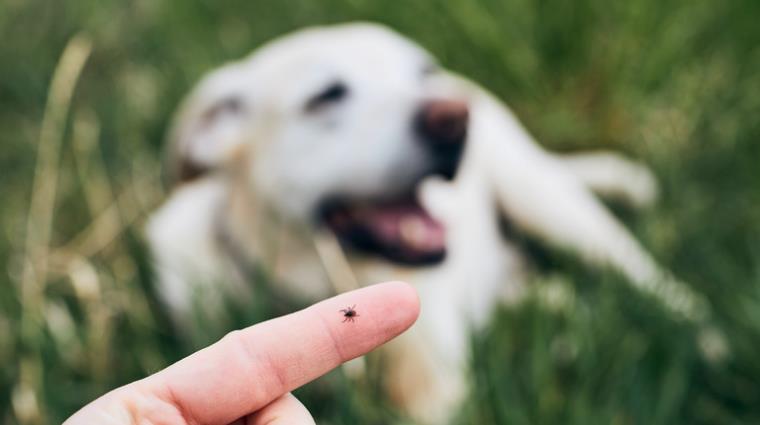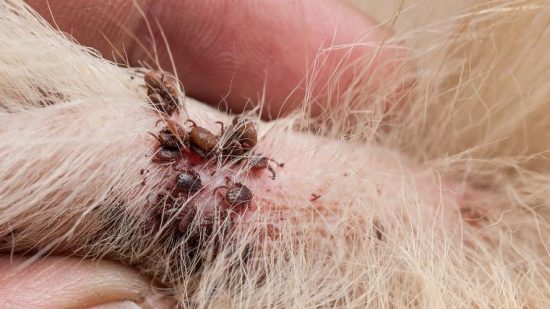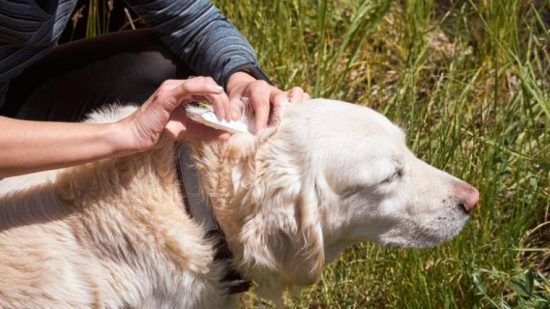What Does an Embedded Tick Look Like on a Dog?

Did you notice that your pets scratch their bodies all the time? It may be because of the ticks on dogs. Embedded ticks on dogs are very common and cause various health issues in dogs. It is very hard to remove ticks from the body, especially for dogs with long fur. The first thing to do is identify the ticks on a dog if you want to remove them. It can be very challenging to detect and move.
Even if you don’t know what an embedded tick looks like on a dog or what signs to look out for, this blog will be your lifesaver.
What are Embedded Ticks?
The tick can be seen attached to the dog’s skin to feed their blood. It can be very difficult to identify and remove. The tick requires blood as its meal to grow and reproduce in each life stage. The tick usually buries its mouthpart to the skin of a dog to suck blood, and that’s why it is called an embedded tick. This attachment can last several days to a week if not removed quickly.
What Are the Signs of Embedded Ticks?
Before checking the ticks, you may see certain signs of your dog that will help identify the parasite. Especially the dogs with thick and long fur, it is very hard to check for ticks. So, here are some signs to look out for:
- Visible Ticks: While you are carrying or bathing a dog, sometimes you can see the ticks that are tightly attached to the skin. It can appear as a small and dark bump.
- Excessive Scratching on Body or Biting: If your dog scratches or bites at a specific area more than usual and more frequently, it may have a chance of ticks.
- Redness and Swelling: Maybe you can find certain body parts of dogs are red and swollen. This may be due to the dog’s blood-feeding or rude scratching.
- Hair Loss: If your dog’s hair is loose around the tick, this area can only be the reason for ticks.
- Scabs or Crusts: The bite site can develop scabs or crusts. So it can be a serious sign.
- Lethargy: Continuous and severe blood feeding of ticks may cause weakness in dogs. Your dog may appear lethargic and tired all the time.
- Fever: For certain dogs, it may cause fever due to tick-borne diseases.
What Does an Embedded Tick Look Like on a Dog?
Usually, the embedded ticks are very small and difficult to spot, especially if it is small. Here’s what to look for:

Color and Size
The embedded ticks are as small as a pinhead and it can only be seen as small spots. They are usually black, or grayish in color, making them blend in with your dog’s fur, especially if your pet has a dark coat. Even if the size is small it can swell to the size of a pea by feeding the blood. This can take a few days to reach this size. In this size, it can be identified more easily.
Shape
The ticks have an oval or round and the shape may change as they feed blood continuously. Before starting, it will be tiny and flat. You will find it very hard to identify at this stage, but after starting feeding you can easily identify it.
Attachment Point
Even though the head and mouth parts are buried in the skin, the body parts will be visible as smaller bumps. So you can identify it by careful observation. For this, you can easily run your hands between the fur of your dog, and you can feel the bump if they have embedded ticks. Especially after feeding will be more helpful.
Movement
The ticks may be attached to the skin, but sometimes their legs might be visible and move slightly. Tick’s leg movement can be used as the best indicator of embedded ticks.
How Can You Check the Tick on Your Dog?
It is always better to check the ticks regularly in your dogs. Especially if your dog has spent time outdoors, you should check regularly. For safety, you should wear gloves and run your hands over the dog’s entire body. You may feel small bumps or lumps in the body. Otherwise, you can comb the fur very gently on the dog’s body. Magnifying glasses are also a very good way to check ticks, especially for thick-furred dogs.
How to Remove the Tick?

When you are removing the ticks from the dog’s skin, it is very important to do it carefully without leaving the parts of the tick behind. The parts of the tick may be trapped in fur and have chances to cause infection.
First, you need tools, fine-tipped tweezers, gloves, antiseptic, and a container for the tick. Wear gloves, and they will protect you from carrying diseases. Use the tweezers, grasp the tick as close to the skiing, and gently pull it back straight. Be careful not to twist or crush it. Then, clean the bitten area with antiseptic soap or shampoo to prevent infection. This may help to calm down your dog from frequent scratching body. Now, you can dispose of the ticks in the toilet and flush them. Always monitor the affected area to find out if any infection occurs or not.
If the trick is deeply embedded in the skin and feels very hard to remove, or it appears even after removing it, you should call a vet and give the proper treatment to your dog.
Preventive Measures for Embedded Ticks on Dogs
You can prevent the ticks embedded in your dog up to a limit. The best easy way to do this is to use tick preventatives such as collars, ointments, or medications that are taken orally as recommended by your vet. Also, remember to do regular checkups, specifically after outdoor activities. Make sure bathe your dog on a daily basis and maintaining a hygienic routine. You can use tick-repellent shampoos suggested by the vet while bathing your dog.
FAQs on Finding Embedded Ticks
Can ticks transmit diseases to dogs?
Yes, ticks will cause several diseases in dogs. Diseases like Lyme disease, ehrlichiosis, and anaplasmosis are examples transmitted by ticks on dogs.
How soon should I remove an embedded tick from my dog?
You can remove the tick immediately after you find it. The longer a tick remains attached, the risk will also increase.
Can I use my fingers without gloves to remove a tick from my dog?
Yes, but not recommended. It is always better to use tweezers with fine tips to make sure you remove the entire body of the tick. Without wearing gloves, it can transmit infections and diseases.
Should I take my dog to the vet after finding an embedded tick?
Contacting the vet or consulting the vet will be the perfect option if you can’t find the tick or feel it is very difficult to remove the tick completely.





